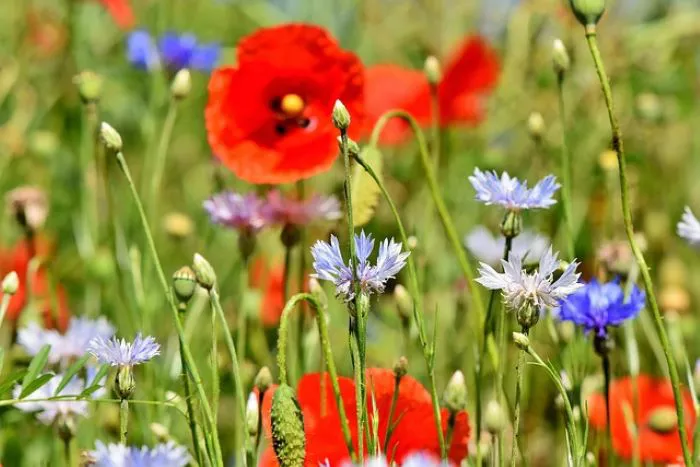Wildflowers are an essential part of our ecosystems. They provide food and habitat for wildlife, improve soil health, and add beauty to landscapes. Many people are interested in growing wildflowers from seed, whether for gardening, conservation, or simply to enjoy their beauty. Understanding how fast wildflowers grow from seed is important for planning and successful cultivation. This article will explore the growth rates of wildflowers, the factors that influence their growth, and tips for successful planting.
The Growth Process of Wildflowers
Wildflowers go through several stages of growth after being planted from seed. The main stages include germination, seedling development, and maturation. Each stage has its own timeline, which can vary significantly depending on the species.
Germination: This is the first stage of growth when the seed absorbs water and begins to sprout. Germination times can range from a few days to several weeks. Factors such as soil temperature, moisture, and seed dormancy affect germination rates. For instance, some wildflower seeds germinate within a week, while others may take up to a month.
Seedling Development: After germination, the plant enters the seedling stage. During this period, the plant develops its first true leaves and establishes its root system. Seedling development can last from a few weeks to several months. The duration depends on the species and environmental conditions. For example, annual wildflowers often grow quickly, while perennials may take longer to establish.
Maturation: The final stage is maturation, where the wildflower produces flowers and seeds. The time it takes to reach maturity varies widely among species. Annual wildflowers typically mature within one growing season, while perennials may take two or more years to flower for the first time.
Factors Influencing Growth Rates
Several factors influence how fast wildflowers grow from seed. Understanding these factors can help gardeners create optimal conditions for growth.
Species Variation: Different wildflower species have unique growth rates. Annual wildflowers generally grow faster than perennials. For example, some annuals, such as the common sunflower, may bloom within 60 to 90 days after planting, while perennials, like coneflowers, may take two to three years to flower.
Environmental Conditions: Temperature, light, soil quality, and moisture levels are crucial for wildflower growth. Most wildflowers thrive in well-drained soil with full sunlight. Warm temperatures can accelerate growth, while cold or damp conditions can slow it down.
Soil Quality: Healthy soil is vital for the growth of wildflowers. Nutrient-rich soil promotes strong root systems and robust growth. Soil that is too compacted or lacks nutrients can hinder growth and delay flowering.
Water Availability: Adequate watering is essential for wildflower growth. Most wildflowers require regular moisture, especially during germination and seedling development. Too much water can lead to root rot, while too little can stunt growth.
Competition: In natural settings, wildflowers compete with grasses and other plants for resources. This competition can influence growth rates. In a cultivated garden, controlling weeds can help wildflowers thrive more quickly.
Growth Timelines for Common Wildflowers
To provide a clearer picture of how fast wildflowers grow from seed, here are examples of common wildflowers and their typical growth timelines.
California Poppy (Eschscholzia californica): This annual wildflower germinates within 7 to 14 days and typically blooms in 60 to 90 days. It grows quickly and produces vibrant orange flowers.
Black-eyed Susan (Rudbeckia hirta): This biennial wildflower may take 10 to 14 days to germinate. It usually flowers in its second year, taking about 18 to 24 months from seed to bloom.
Common Bluebell (Hyacinthoides non-scripta): This perennial wildflower can take 14 to 30 days to germinate. It usually blooms in its second year, taking about 18 to 24 months to reach maturity.
Wild Lupine (Lupinus perennis): This perennial wildflower germinates in 10 to 14 days. It typically takes 2 to 3 years to bloom, making it a slower-growing option.
Coneflower (Echinacea purpurea): This perennial wildflower germinates in 7 to 14 days and usually flowers in its second or third year, taking about 2 to 3 years to reach full maturity.
Tips for Successful Wildflower Cultivation
To ensure successful growth of wildflowers from seed, consider the following tips:
Choose the Right Species: Select wildflower species that are suited to your local climate and soil conditions. Native species are often the best choice as they are adapted to local environments.
Prepare the Soil: Before planting, prepare the soil by removing weeds and debris. Loosen the soil to improve drainage and aeration. Adding organic matter can enhance soil fertility.
Plant at the Right Time: Timing is crucial for wildflower growth. Most wildflowers should be planted in the spring or fall, depending on the species. Follow local planting guidelines for optimal results.
Water Wisely: Provide adequate moisture during the germination and seedling stages. Once established, many wildflowers require less frequent watering. Be careful not to overwater, as this can lead to root problems.
Monitor Growth: Keep an eye on the growth of your wildflowers. Look for signs of pests or diseases and take action if necessary. Regular maintenance, such as weeding and mulching, can help your wildflowers thrive.
Conclusion
Wildflowers can grow from seed at varying rates, influenced by species and environmental conditions. Understanding the growth stages of wildflowers, from germination to maturity, is essential for successful cultivation. By choosing the right species, preparing the soil, and providing appropriate care, gardeners can enjoy the beauty of wildflowers in their landscapes. Whether for ecological restoration or personal enjoyment, cultivating wildflowers enriches our environment and enhances biodiversity.


